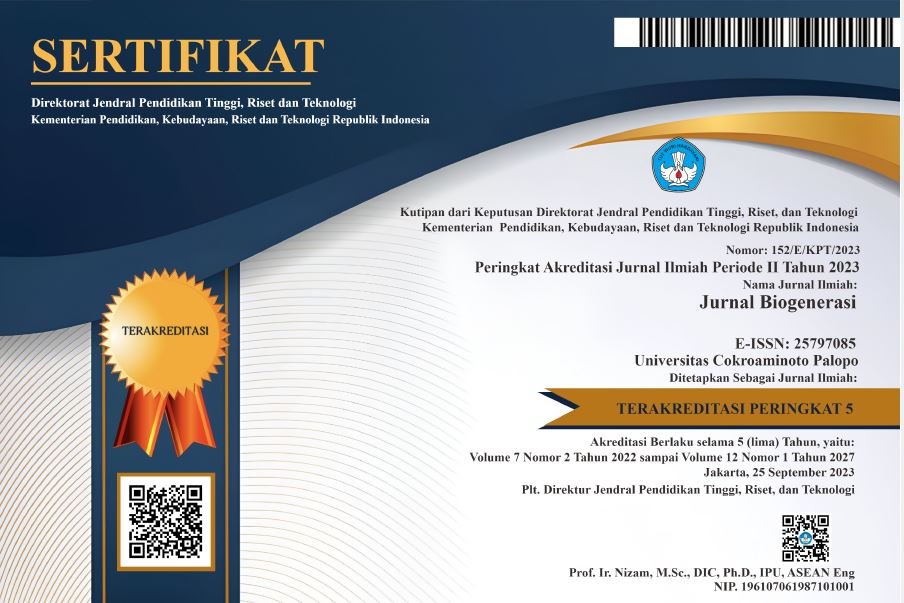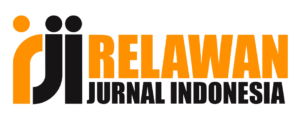KANDUNGAN MIKROPLASTIK GARAM TAMBAK DI JUWANA – KABUPATEN PATI, JAWA TENGAH
DOI:
https://doi.org/10.30605/biogenerasi.v7i2.1905Keywords:
garam, juwana, mikroplastik, tambak.Abstract
Garam adalah kebutuhan esensial bagi manusia. Produksi garam konsumsi dilakukan dengan kristalisasi air laut dengan penguapan. Laut yang tercemar mikroplastik berpotensi menyumbangkan cemaran mikroplastik pada produk garam konsumsi. Mikroplastik pada garam akan masuk ke dalam tubuh saat dikonsumsi, yang berpotensi menyebabkan gangguan kesehatan. Tujuan dari penelitian ini adalah untuk menganalisis kandungan mikroplastik pada garam tambak. Metode yang digunakan adalah kuantitatif deskriptif, dengan tahapan penelitian preparasi sampel dengan pengapungan dan analisis sampel secara mikroskopis dan analisis kadar garam. Hasil penelitian menunjukan, garam mengandung mikroplastik sebanyak 15,67 ± 4,73 par/100gr. Solusi yang bisa dilakukan untuk meminimalkan cemaran mikroplastik adalah dengan penyaringan air laut dan pembersihan permukaan air garam.
Downloads
References
Giyatmi, Irianto, H.E. 2021. Mikroplastik Pencemar Pangan Baru. Inovasi Teknologi Pangan Menuju Indosia Emas. IPB PRess. Bogor.
Kortekaas K.H, Fegies A.C, de los Monteros López C.E, de la Fuente M.B, Polo C.M, Carretero R.C, Castro M.del.M.C. 2021. Microplastics in food-grade salt: how bad is the problem?. El Alfolí.Vol.28:11-19.
Karami A, Golieskardi A, Choo A.K, Galloway T.S, Salamatinia B. 2017. The presence of microplastics in commercial salts from different countries. Scientific Reports | 7:46173 | DOI: 10.1038/srep46173. www.nature.com/scientificreports/
Kompas 5 Januari. 2022.Produksi Garam Rakyat Ditargetkan 1,5 Juta Ton pada 2022.
Kompas 16 Juni 2022, Mikroplastik di Makanan dan Minuman Kita.
Lestari K, Haeruddin , Jati O.E. 2021. Karakterisasi Mikroplastik dari Sedimen Padang Lamun, Pulau Panjang, Jepara, Dengan Ft-Ir Infra Red. Jurnal Sains dan Teknologi Lingkungan. Vol.13(2):135-154
Maria E. Iñiguez, Juan A. Conesa & Andres Fullana. 2017. Microplastics in Spanish Table Salt. Scientific REPOrTS Vol.7: 8620 | DOI:10.1038/s41598-017-09128-x.
Mauludy M.S, Yunanto A, Yona D. 2019. Kelimpahan Mikroplastik pada Sedimen Pantai Wisata Kabupaten Badung, Bali. Jurnal Perikanan Universitas Gadjah Mada.Vol.21(1):99-104.
Parvin F, Nath J, Hannan T, Tareq S.M. 2022. Proliferation of microplastics in commercial sea salts from the world longest sea beach of Bangladesh. Environmental Advances. Vol.7:100173
Peixotoa D, Pinheiroa C, Amorima J, Oliva-Telesa L, Guilherminoa L, Vieiraa M.N, 2019. A review-Microplastic pollution in commercial salt for human consumption. Estuarine, Coastal and Shelf Science.Vol.219: 161–168.
Ramadhanty N.R,Sumantri S.H, Suwarno P, Supriyadi. 2020. Analisis Kandungan Mikroplastik pada Ekosistem Pesisir dan Produk Garam di Provinsi Sulawesi Barat dalam Mendukung Blue Economy Keamanan Maritim. Jurnal Education and development Institut Pendidikan Tapanuli Selatan. Vol.8(4).
Suroso. 2015. Potensi dan Eksistensi Produksi Garam Konsumsi di Kabupaten Pati. Jurnal Litbang Vol.11(1):3-11.
Sugandia D, Agustiawana D, Febriyanti S.V, Yudia Y, Wahyunia N. 2021. Identifikasi Jenis Mikroplastik dan Logam Berat di Air Sungai Kapuas Kota Pontianak. POSITRON.Vol. 11(2):112 - 120. DOI:10.26418/positron.v11i2.49355
Tahir A, Taba P, Samawi M.F, Werorilangi S. 2019. Microplastics in water, sediment and salts from traditional salt producing ponds. Global Journal of Environmental Science and Management. Vol.5(4):431-440.
Tambunan B.R, Hariyadi, Santoso A. 2012. Evaluasi Kesesuaian Tambak Garam Ditinjau Dari Aspek Fisik Di Kecamatan Juwana Kabupaten Pati. Journal Of Marine Research. Vol.1(2):181-187.
Zhang Q, Genbo-Xu E, Li J, Chen Q, Liping Ma, Zeng E.Y, Shi H. 2021. A Review of Microplastics in Table salt, Drinking Water, and Air: Direct Human Exposure. Environmental Science & Technology. American Chemical Society. 1-33. DOI: 10.1021/acs.est.9b04535
Downloads
Published
How to Cite
Issue
Section
License
In submitting the manuscript to the journal, the authors certify that:
- They are authorized by their co-authors to enter into these arrangements.
- The work described has not been formally published before, except in the form of an abstract or as part of a published lecture, review, thesis, or overlay journal.
- That it is not under consideration for publication elsewhere,
- That its publication has been approved by all the author(s) and by the responsible authorities – tacitly or explicitly – of the institutes where the work has been carried out.
- They secure the right to reproduce any material that has already been published or copyrighted elsewhere.
- They agree to the following license and copyright agreement.
License and Copyright Agreement
Authors who publish with this journal agree to the following terms:
- Authors retain copyright and grant the journal right of first publication with the work simultaneously licensed under Creative Commons Attribution License (CC BY 4.0) that allows others to share the work with an acknowledgment of the work's authorship and initial publication in this journal.
- Authors are able to enter into separate, additional contractual arrangements for the non-exclusive distribution of the journal's published version of the work (e.g., post it to an institutional repository or publish it in a book), with an acknowledgment of its initial publication in this journal.
- Authors are permitted and encouraged to post their work online (e.g., in institutional repositories or on their website) prior to and during the submission process, as it can lead to productive exchanges, as well as earlier and greater citation of published work.


.png)

